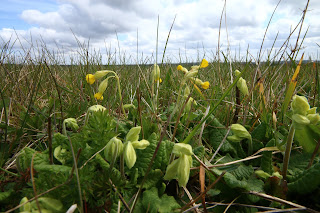There were hundreds on the village green. If there was a habitat preference it was for areas where there was less competition from grasses and more aggressive plants, because the Muscari were both out in the open, accompanied by cowslips, but also under bushes in shade. There is a widely held view that they prefer a south-facing, dry corner but looking closely today I don't think that is necessarily the case.
 |
| Muscari neglectum |
 |
| Village Green, Chadlington |
 |
| Edge of Arable Field, Chadlington |
 |
| Cowslips |
I almost forgot; unlike most TV personalities he is actually a lot taller than he looks on the screen!
I do wonder if at one time Muscari neglectum was found in some of the arable fields around Hook Norton, because quite a few of the gardens in the village, especially the older cottages, have the plant. Druce's Flora of Oxfordshire has a record from 1881 at Adderbury and the Chadlington site, which are not too far away.
There are also some possible hybrids of M. neglectum and the common garden Grape hyacinth M. armeniacum. I found, though, on a very brief review, an interesting PhD thesis by Ylva Heed which concludes that M. neglectum has several ploidal levels such that species boundaries are hard to define (http://bioenv.gu.se/digitalAssets/1325/1325065_ylva-heed.pdf). I will collect examples over the next few days of the pure plants and intermediates in and around the village. Not that I will be able to make any contribution to science in this molecular age.
Thanks Terry, a very interesting post - and I think it is still possible "in this molecular age" for field botanists to make a huge contribution to science, by recording what grows where and sending records to the BSBI County Recorder for adding to the Database.
ReplyDeleteAbsolutely right, but I think it can go beyond simply recording. The long run data sets on Muscari and Gagea which Ken and Barbara have developed are really interesting in that they may shed light on why a species thrives or otherwise. For instance
DeleteI am planning to link these to climate data to see if there are any correlations
Sounds interesting! Any chance that you will be writing up your research and submitting it to New Journal of Botany?
DeleteSounds interesting! Any chance that you will be writing up your research and submitting it to New Journal of Botany?
DeleteThis is far too trivial!
ReplyDelete